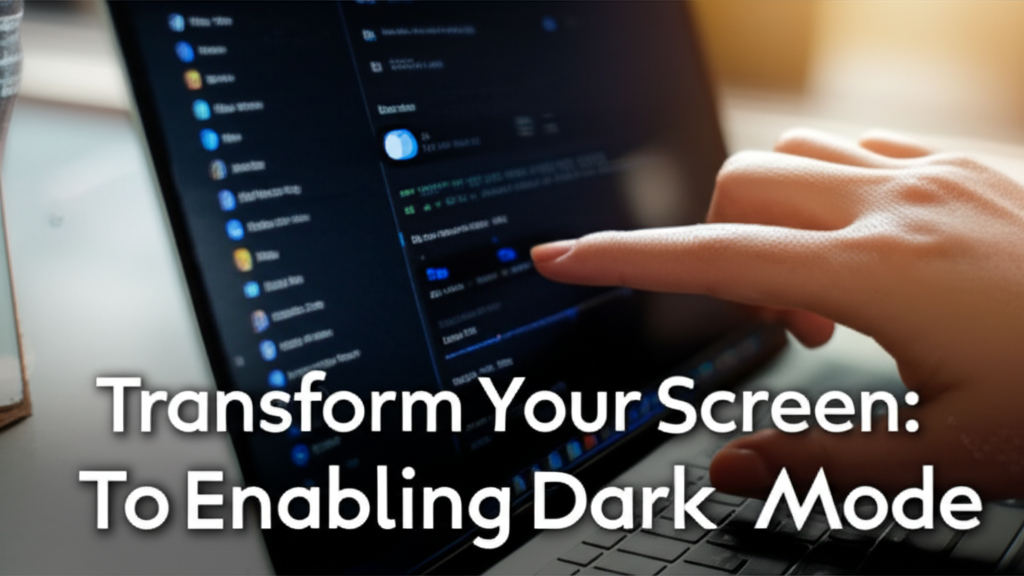Introduction
In a world where we spend countless hours in front of screens, the strain on our eyes is becoming an increasing concern. Whether you’re working late on a project or binge-watching your favorite series, the bright white backgrounds of Windows applications can contribute to fatigue and discomfort. Enter Dark Mode – a feature that not only looks aesthetically pleasing but also helps reduce eye strain.
This guide will provide a clear, step-by-step breakdown for enabling Dark Mode in various Windows applications. The best part? You don’t need to be a tech wizard to do it! Let’s dive in and transform your screen for a more comfortable experience.
Why Dark Mode?
Benefits of Dark Mode:
- Less Eye Strain: Darker colors are generally easier on the eyes, especially in low-light conditions.
- Battery Saving: On OLED screens, dark backgrounds can help save battery life since black pixels consume less power.
- Improved Focus: Many users find it easier to concentrate on tasks with a less distracting interface.
Step-by-Step Breakdown
Step 1: Enable Dark Mode in Windows Settings
Before you delve into individual applications, you’ll want to start with your overall Windows settings.
Instructions:
-
Open Settings:
- Press
Win + Ion your keyboard to open the Settings app.
- Press
-
Navigate to Personalization:
- Click on Personalization.
-
Select Colors:
- In the left sidebar, click on Colors.
- Choose Your Color:
- Under the "Choose your color" dropdown, select Dark.
Screenshot: [Add screenshot of Windows Settings > Personalization > Colors]
Step 2: Enable Dark Mode in Microsoft Office Apps
If you’re using Office apps like Word, Excel, or PowerPoint, enabling Dark Mode will enhance your experience.
Instructions:
-
Open an Office App:
- Start Word, Excel, or PowerPoint.
-
Go to File:
- Click on File in the top left corner.
-
Select Options:
- At the bottom, click on Options.
- Change the Theme:
- In the General section, find "Personalize your copy of Microsoft Office."
- From the "Office Theme" dropdown, select Black or Dark Gray.
Screenshot: [Add screenshot of Office Options menu]
Step 3: Enable Dark Mode in Microsoft Edge
If you browse the web using Microsoft Edge, you can switch it to Dark Mode too.
Instructions:
-
Open Microsoft Edge:
- Launch the Edge browser.
-
Go to Settings:
- Click on the three dots in the top right corner, then select Settings.
-
Choose Appearance:
- From the sidebar, click on Appearance.
- Select Theme:
- Under "Theme," select Dark.
Screenshot: [Add screenshot of Edge Settings menu]
Step 4: Enable Dark Mode in Other Common Apps
Here are steps to activate Dark Mode in popular applications:
Google Chrome:
- Open Chrome.
- Type
chrome://flagsin the address bar and hit Enter. - Search for “Force Dark Mode for Web Contents.”
- Set it to Enabled.
- Relaunch Chrome.
Firefox:
- Open Firefox.
- Click the three horizontal lines in the top right corner.
- Select Add-ons and Themes.
- Click on Themes in the left menu and click on Dark to enable it.
Other Apps:
- Many applications like Slack, Discord, and Spotify have their own dark mode settings usually found in the app’s preferences or settings menu.
Common Mistakes Beginners Make
- Forgetting to Save Changes: When making changes in settings, always ensure you click “OK” or “Apply.”
- Overlooking App-Specific Settings: Even if Windows is set to Dark Mode, some applications may need individual adjustments.
- Skipping Updates: Make sure your apps and Windows are up to date to avoid missing out on new features or bugs.
Alternative Methods or Tools
Third-Party Tools
If you want a more customizable experience, consider using third-party applications.
- f.lux: This tool adjusts your screen’s color temperature based on your time of day.
- Night Owl: A tool that allows users to manage multiple settings across their applications for optimal viewing.
Using High Contrast Themes
For those who require more contrast than Dark Mode offers, you can also explore High Contrast themes in Windows:
- Open settings with
Win + I. - Go to Ease of Access > High Contrast.
- Select a high contrast theme.
Final Checklist
Before you finish, confirm that you’ve completed each of these tasks:
- [ ] Enabled Dark Mode in Windows Settings.
- [ ] Changed Dark Mode settings in Microsoft Office.
- [ ] Updated Dark Mode settings in Microsoft Edge.
- [ ] Configured Dark Mode in other relevant applications.
- [ ] Ensured all settings saved successfully without error.
Conclusion
Congratulations on transforming your screen to Dark Mode! You’ve taken a significant step towards a more comfortable and visually pleasing experience on your PC. With less eye strain and improved focus, your overall productivity could increase.
Feel free to revisit this guide anytime you want to make changes or explore more applications. Happy computing!

